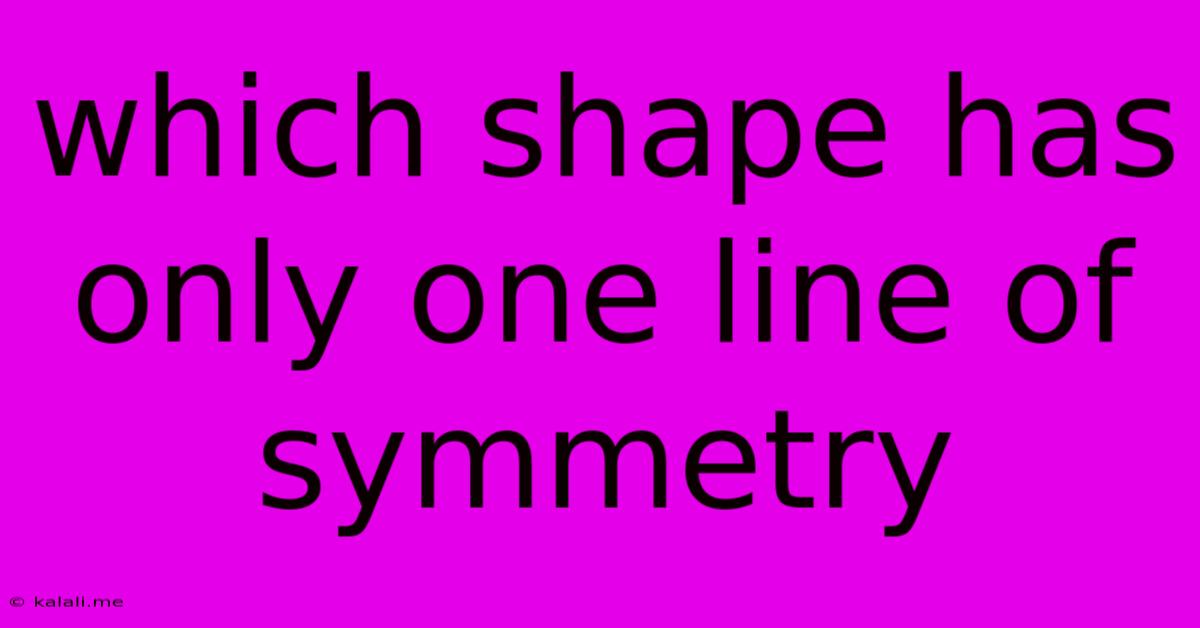Which Shape Has Only One Line Of Symmetry
Kalali
Jun 12, 2025 · 3 min read

Table of Contents
Which Shape Has Only One Line of Symmetry? Unlocking the Secrets of Geometric Symmetry
Symmetry, a fundamental concept in geometry and art, describes the balanced distribution of shapes and sizes within a figure. Understanding lines of symmetry is key to appreciating the elegance and underlying structure of many shapes. This article delves into the fascinating world of symmetry, focusing specifically on the question: which shape has only one line of symmetry? We'll explore various shapes and their symmetries, providing a clear and concise answer while enriching your understanding of geometric properties.
Many shapes possess multiple lines of symmetry, some even possessing an infinite number! However, some shapes are more unique, possessing a singular line of symmetry that divides them into two perfectly mirrored halves. This characteristic distinguishes them in the world of geometric shapes. Let's explore some examples to understand this concept better.
Shapes with Multiple Lines of Symmetry
Before we identify the shape with only one line of symmetry, let's quickly review some shapes that exhibit multiple lines of symmetry:
- Circle: A circle has an infinite number of lines of symmetry, as any line passing through its center will divide it into two identical halves.
- Square: A square possesses four lines of symmetry: two diagonals and two lines connecting the midpoints of opposite sides.
- Rectangle (non-square): A rectangle has two lines of symmetry, both running through the midpoints of opposite sides.
- Equilateral Triangle: An equilateral triangle has three lines of symmetry, each passing through a vertex and the midpoint of the opposite side.
The Shape with Only One Line of Symmetry: The Isosceles Triangle
Now, let's address the central question. The shape that typically possesses only one line of symmetry is the isosceles triangle.
An isosceles triangle is defined as a triangle with at least two sides of equal length. This equality of sides leads to a single line of symmetry: a line that bisects the angle between the two equal sides and also perpendicularly bisects the opposite side (the base). This line perfectly mirrors the two halves of the triangle.
Important Note: While an isosceles triangle typically has only one line of symmetry, there's an exception. If the isosceles triangle is also equilateral (meaning all three sides are equal), then it has three lines of symmetry.
Understanding Line Symmetry: A Deeper Dive
A line of symmetry, also known as a line of reflection, is a line that divides a shape into two congruent halves that are mirror images of each other. When you fold the shape along the line of symmetry, the two halves perfectly overlap. The concept of line symmetry is widely used in various fields, from art and design to architecture and engineering.
Beyond the Basics: Exploring Other Types of Symmetry
While line symmetry is our focus here, it's worth noting that other types of symmetry exist, such as:
- Rotational Symmetry: A shape possesses rotational symmetry if it can be rotated by a certain angle and still look the same.
- Point Symmetry: A shape has point symmetry if it looks the same when rotated 180 degrees around a central point.
Understanding different types of symmetry helps us analyze and appreciate the beauty and complexity of shapes in the world around us.
In conclusion, while many shapes display multiple or even infinite lines of symmetry, the isosceles triangle (excluding equilateral triangles) stands out as a shape typically having only one line of symmetry. This unique characteristic highlights the diverse world of geometric properties and their applications across various fields.
Latest Posts
Latest Posts
-
What Is The Integral Of Xlnx
Jun 13, 2025
-
Drastic Times Call For Drastic Measures
Jun 13, 2025
-
Which Of The Following Is An Example Of Disinfection
Jun 13, 2025
-
Difference Between A Quota And A Tariff
Jun 13, 2025
-
Which Chamber Of The Heart Has The Thickest Muscular Wall
Jun 13, 2025
Related Post
Thank you for visiting our website which covers about Which Shape Has Only One Line Of Symmetry . We hope the information provided has been useful to you. Feel free to contact us if you have any questions or need further assistance. See you next time and don't miss to bookmark.